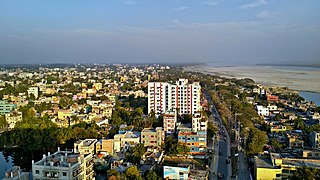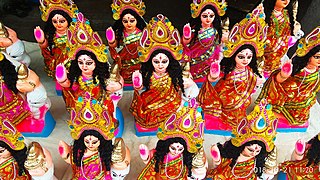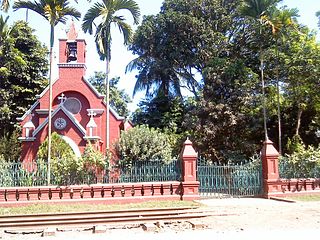
Tripura is a state in northeastern India. The third-smallest state in the country, it covers 10,491.69 km2 (4,050.86 sq mi) and is bordered by Bangladesh to the north, south, and west, and the Indian states of Assam and Mizoram to the east. In 2011 the state had 3,671,032 residents, constituting 0.3% of the country's population.

Rajshahi Division is one of the eight first-level administrative divisions of Bangladesh. It has an area of 18,174.4 square kilometres (7,017.2 sq mi) and a population at the 2011 Census of 18,484,858. Rajshahi Division consists of 8 districts, 70 Upazilas and 1,092 Unions.

Rajshahi is a metropolitan city and a major urban, commercial and educational centre of Bangladesh. It is also the administrative seat of the eponymous division and district. Located on the north bank of the Padma River, near the Bangladesh-India border, the city has a population of over 763,580 residents. The town is surrounded by the satellite towns of Nowhata and Katakhali, which together build an urban agglomeration of about 1 million population. Modern Rajshahi lies in the ancient region of Pundravardhana. The foundation of the city dates to 1634, according to epigraphic records at the mausoleum of Sufi saint Shah Makhdum. The area hosted a Dutch settlement in the 18th century. The Rajshahi municipality was constituted during the British Raj in 1876. It was a divisional capital of the Bengal Presidency.
The culture of Bangladesh is intertwined with the culture of the Bengal region. It has evolved over the centuries and encompasses the cultural diversity of several social groups of Bangladesh. The Bengal Renaissance of the 18th early 19th centuries, noted Bengali writers, saints, authors, scientists, researchers, thinkers, music composers, painters, film-makers have played a significant role in the development of Bengali culture. The Bengal Renaissance contained the seeds of a nascent political Indian nationalism which was the precursor in many ways to modern Indian artistic cultural expression.
The Mahli are a community in the Indian states of Jharkhand, Odisha and West Bengal. Basketry was main occupation of mahlis. Mahli speak Sadri, Mundari and Santali as their mother tongue rather than Mahli. May be Mahli is a threatened language. Also use Bengali, Hindi and Odia. They are included in list of Scheduled Tribe.

Sharad Purnima is a religious festival celebrated on the full moon day of the Hindu lunar month of Ashvin, marking the end of the monsoon season. The full moon night is celebrated in different ways in various cultural regions across South Asia.

Syedpur (Syedpur) is a city of Nilphamari district in Rangpur Division of Bangladesh. The city has become a very important communication hub for adjoining major district headquarters. Syedpur Airport is one of the domestic airports in Bangladesh. The Syeddpur Railway Workshop, established in 1870, is the largest in Bangladesh and was the major railway workshop for Assam-Bengal railway. The city has historically been an Urdu-speaking community with close ties to Bihar.

Khonds are an indigenous Adivasi tribal community in India. Traditionally hunter-gatherers, they are divided into the hill-dwelling Khonds and plain-dwelling Khonds for census purposes; All the Khonds identify by their clan and usually hold large tracts of fertile land but still practice hunting, gathering and slash-and-burn agriculture in the forests as a symbol of their connection to and ownership of the forest. Khonds speak the Kui and Kuvi languages and write them in Odia script.
The Tribal people of Bangladesh refer to ethnic minorities in Chittagong Hill Tracts (southeastern), Sylhet Division (northeastern), Rajshahi Division (west), and Mymensingh Division (north-central) areas of the country. They are not indigenous rather they are the tribal races, total population of ethnic minorities in Bangladesh was estimated to be over 2 million in 2010. They are diverse ethnic communities including Tibeto-Burman, Austric and Dravidian people. Indigenous people of Bangladesh are the mainstream people originating from Dravidian, Indo-Aryan, Middle Eastern and Asiatic ancestry.
Sapahar is an Upazila of Naogaon District in the Division of Rajshahi, Bangladesh.
Tanore is an Upazila of Rajshahi District in the Division of Rajshahi, Bangladesh. Tanore police station was established in February 1869 and it was declared sub-district or upazila in 1983.

The culture of Bengal defines the cultural heritage of the Bengali people native to eastern regions of the Indian subcontinent, mainly what is today Bangladesh and the Indian states of West Bengal and Tripura, where the Bengali language is the official and primary language. Bengal has a recorded history of 1,400 years. The Bengali people are its dominant ethnolinguistic group. The region has been a historical melting point, blending indigenous traditions with cosmopolitan influences from pan-Indian subcontinental empires. Bengal was considered to be the richest part of Islamic medieval India and during the era of the Bengal Sultanate it was described to be a major trading nation in the world, while during Mughal times, having triggered the proto-industrialization, its economy was worth 12% of global GDP. However, significant socio-economic inequalities existed during this period. As a part of the Bengal Presidency, it also hosted the region's most advanced political and cultural centers during British rule. Historically Feudalism has been widespread in the entire eastern Indian region. The feudal system flourished to a large extent under the British administration, which served as a means to exploit the Indian peasants by the British colonizers. This created a class of rich landlords in Bengal and a large population of poor peasants. It is noteworthy that a major portion of the Bengali intellectual community during the British era emerged from this wealthy class of landlords, as primarily they belonged to well educated families and got the economic opportunities to receive English education, often from abroad. The lower social classes remained in abject poverty and illiteracy. Thus, although the contribution of the Bengali intellectual community has been immense towards literature, science, politics and the Indian freedom movement, but still as it flourished under an exploitative imperial government, it mostly constituted of individuals belonging to the wealthy landlord families.

The national language and official language of Bangladesh is Bengali according to the third article of the Constitution of Bangladesh. The second most spoken language in Bangladesh is claimed to be Burmese which is spoken by the Marma tribe in Chittagong Hill districts as the districts border Myanmar and it's also spoken by the Rohingya people. 98% of Bangladeshis are fluent in Bengali as their first language. Bengali Language Implementation Act, 1987 made it mandatory to use Bengali in all government affairs except in the cases of foreign relations. According to a 2011 census, Bengali is predominantly spoken by 98% of the country's population and it also serves as the national language of the nation. The indigenous people of northern and southeastern Bangladesh speak a variety of native languages.
The Halam community are various tribes native to the state of Tripura in India. The name Halam was coined by the Tipra Maharaja. As per their oral tradition they called themselves "Riam", which literally means "Human being". And lyrically they also call themselves "Riamrai, Raivon, Longvon, Chepvon etc.". The Halam are further divided into 12 sub-tribes, namely Chorai, Molsom, Hrangkhol, Kaipeng, Kalai, Ranglong, Sakachep, Thangachep, Bongcher, Korbwng, Dab and Rupini.

The culture of Tripura is distinct and a bit similar to other people of Northeast India. However like Assam, Manipur, Burma and Southeast Asia culture of Tripura is characterized in small portion where people live in plain and hill areas. Tripura is a state in North East India. In the 2001 census of India, Bengalis represented almost 70% of the population and the Tripuri population comprised 30% of Tripura's population. The Tripuri population comprises some clans and ethnic groups with diverse languages and cultures. The largest native group was the Tripuri who had a population of 543,848 in 2001 census, representing 16.99% of the state population and 54.7% of the scheduled tribe population. The other group of people in order of decreasing population were Chakma (6.5%), Halam (4.8%), Mog (3.1%), Munda, Kuki tribes and Garo Hajong. Bengali is the most spoken language, due to the dominance of Bengali people in the state. Kokborok (Tripuri/Tiprakok) is a common language among Tripuris and lingua franca in Tripura. Several other languages belonging to Indo-European and Sino-Tibetan families are spoken by the different tribe

Hinduism is the largest religious tradition in the Indian state of West Bengal with approximately 70.5% of the population identifying themselves as Hindus . The Hindus in West Bengal mostly belong to the Shakta, minority to Vaishnavite and a small community belong to Shaivite and other denominations. The vast majority of Hindus in West Bengal are Bengali Hindus numbering around 5.6 crore and comprising 55.5% of the state population of 11 crore(2011) but a notable section of non-Bengali Hindus also exist, particularly among Marwaris, Biharis, Odias, Gurkhas, Sindhis, Gujaratis and various tribal communities such as Koch, Santals, Munda and particularly Adivadis numbering around 1.557 crore comprising rest 15% of the state population.

Bhumij is a Munda ethnic group of India. They primarily live in the Indian states of West Bengal, Odisha, and Jharkhand, mostly in the old Singhbhum district. Also in states like Bihar and Assam. There is also a sizeable population found in Bangladesh. Bhumijas speak the Bhumij language, an Austroasiatic language, and use Ol Onal script for writing.

The Mru, also known as the Mro, Murong, Taung Mro, Mrung, and Mrucha, refer to the tribes who live in the border regions between Myanmar (Burma), Bangladesh, and India. The Mru are a sub-group of the Chin people, a few of whom live in western Myanmar. They are also found in the northern Rakhine State. In Bangladesh, they reside in the Chittagong Hills in southeast Bangladesh, primarily in Bandarban District and Rangamati Hill District. In India, they reside in West Bengal.

The Hajong people are an ethnic group from Northeast India and northern parts of Bangladesh. The majority of the Hajongs are settled in India and are predominantly rice-farmers. They are said to have brought wet-field cultivation to Garo Hills, where the Garo people used slash and burn method of agriculture. Hajong have the status of a Scheduled Tribe in India and they are the fourth largest tribal ethnicity in the Indian state of Meghalaya.
The Barman Kacharis are an indigenous community of Northeast India and are a subsection of the Dimasa people in Barak Valley but claim to a separate group in Brahmaputra Valley. They are mainly found in the districts of Lower Assam and in Barak Valley like Cachar, Hailakandi and Karimganj and some parts of Arunachal Pradesh. Barman Kachari is Dimasa convert group of North-East India. Since the 2002 Amendment act, many Barman Kacharis in Assam are referred to as 'Barman'. They are sparsely found in Brahmaputra valley.













